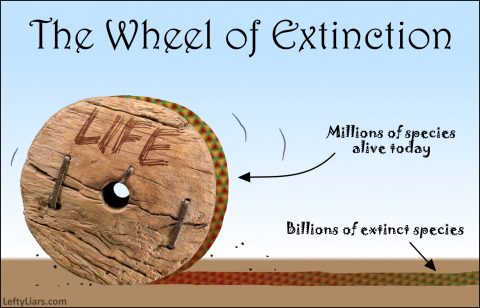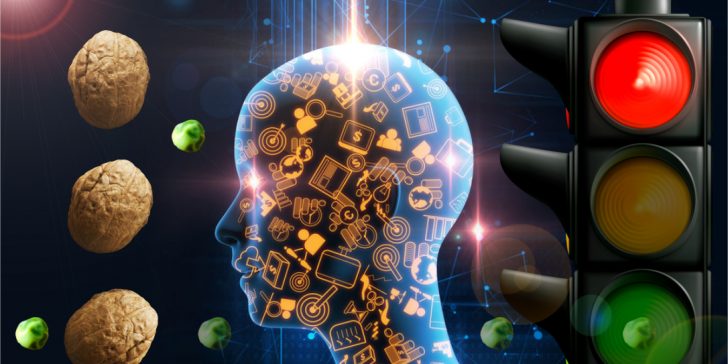
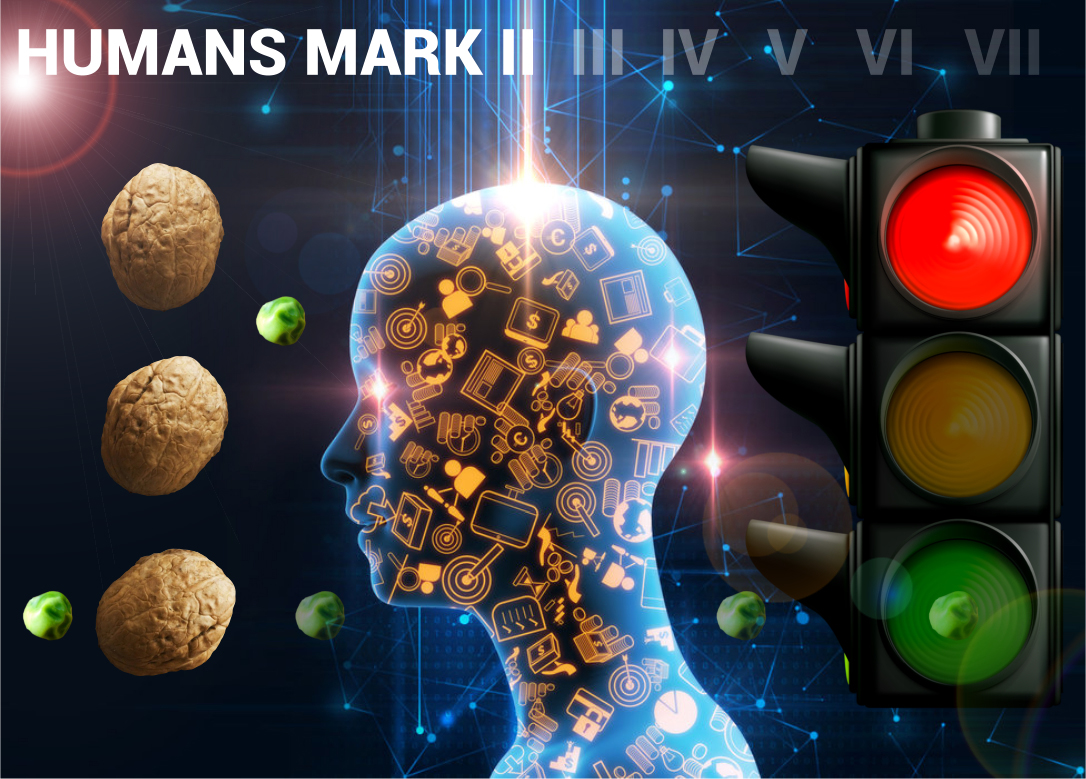
Five groups need to read this article: voters, reporters, public servants, students, and parents. Who knows, it could change your life, either now or sometime in the future.
Modern humans are a subspecies of Homo sapiens, called Homo sapiens sapiens, and have not changed genetically for tens of thousands of years. For this article, I will rename us Homo sapiens sapiens 1.0, or, put another way, Humans 1.0. Hopefully, Humans 1.1 will come along soon.
Humans 1.0 have flaws taken advantage of by thieves, liars, con artists, and assorted rogues. Take the ancient Shell Game, for example. It is a hoax, using three walnut shells, a pea, and sleight of hand.

A scam artist places the pea under shell one before shuffling all three shells and inviting “players” to bet on the pea’s location. While he moves shell one around, he tilts it just enough to remove the pea with his middle finger and thumb from the back. He then tips shell three just enough to slip the pea under it from the rear. Victims are sure the pea is under one, yet it is under three, and they lose their money.
Victims assume they were at fault and bet again, sure they will win the next time, but fail repeatedly. The con artist is so fast victims cannot see the pea being removed and reloaded. It is a 500-year-old deception, and humans fall for it like eggs from tall chickens. This expert shows how the scam is performed.
When Humans 1.0 evolve into Humans 1.1, perhaps they will see what the con artist is doing. They would deduce he was removing the pea and placing it under other shells. They would never throw their money away, betting on such a scam.
Traffic Lights
Another example of the limitations found in Humans 1.0 is their inability to figure out when traffic lights are necessary or not, and this failing kills many people every year. Future humans will have no such difficulty. What may seem a very straightforward exercise in logic becomes profoundly difficult for Humans 1.0, especially those working in governments. Whether on a local, state, or federal level, public servants seem at a loss regarding traffic lights.

As an example, a park is developed beside a major road. Motorists from the park must halt at a stop sign and only proceed when it is safe. Every year thirty million vehicles pass this point, including cars, trucks, buses, motorcycles, mobile homes, etc.
In the first year, a motorist fails to stop at the stop sign, crashes into a truck, and is killed, so a local government traffic official, Moe Lester, decides to install traffic lights at the T-junction. “After all,” Lester reasons, “people commonly go through stop signs, but not so often through red lights, and if it saves one person’s life, it’s worth it.”
It makes perfect sense to a Human Mark I, just as the pea being under shell one made perfect sense. Human Mark II would see many problems with the idea and how lethal it was. He would say, “Installing traffic lights will cause many additional deaths each year.”
Moe Lester would scoff, “How could traffic lights kill extra people? It makes no sense at all!”
Yet Human 2.0 is correct.
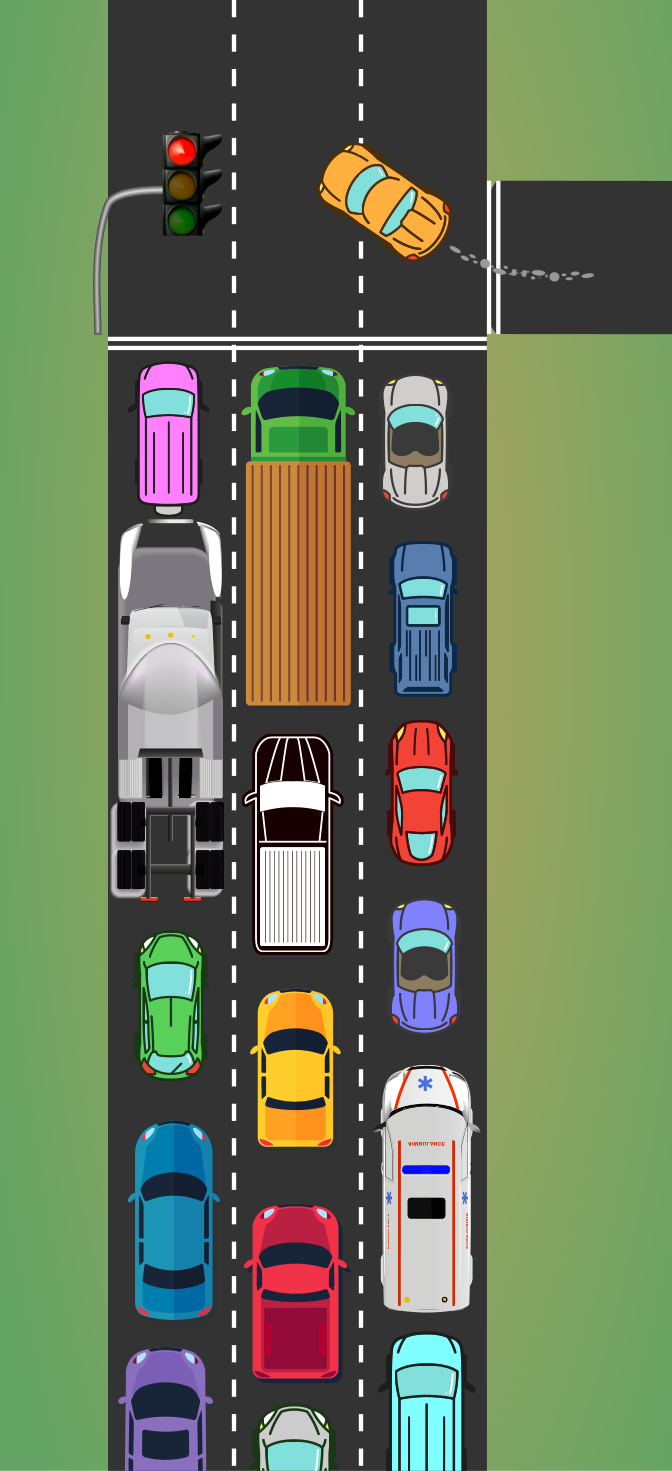
In theory, the traffic lights will stop about four million vehicles per year, but they will stop about ten million in reality. A delayed ripple effect moves through backed-up traffic in peak hour times, halting vehicles way down the back of the traffic snarl, even while the traffic is moving again at the front.
Drivers will stop at the end of this ripple, wait for traffic to move, and slowly move forward, only to be blocked by another red light. They might be sitting in the line for five or ten minutes before passing the lights. Ten million vehicles are delayed for about one minute each year. That is ten million minutes, or 6944 days, which is about 19 years.
What is the cost of ten million vehicles applying brakes, winding down gears, slowing to a halt, idling engines for a minute, accelerating again, changing gears, gaining speed, and returning to normal driving? How much gas and oil are used during that time?
How much wear and tear impacts brakes, gears, clutches, engines, tires, shock absorbers, carburetors, air conditioners, windshield wipers, and hundreds of other components? Let us say that slowing down, stopping, idling, starting up again, accelerating, and driving away cost each vehicle fifty cents to five dollars, depending on its size, age, power, and weight, which might average out to a dollar each.
To prevent one fatality a year, that’s ten million vehicles, ten million dollars, and nineteen years’ worth of time. But that amount of work, cost, and time will cost society, including lives lost. How do such things happen?
No state bureaucrat ever studies case samples of this kind, which we will show as we go along. However, the sketches are based on stories we read about each day, played out in real life.

Example I: Ken
Ken, a sixty-five-year-old man, suffers at home, finding it hard to breathe. His inhaler is empty. Additionally, he feels a pain in his chest, near his heart. Ken decides to go to the pharmacy to buy a couple of new inhalers before dropping by the hospital regarding his chest pains. He jumps in his car and begins driving to the pharmacy. On the way, he calls the hospital to book an appointment.
As he approaches the T-intersection shown above, Ken notices a lot of traffic piled up, bumper to bumper. “It’s that damned new traffic light,” he gasps, braking to a halt. After three minutes of stressful starting and stopping, Ken finally reaches the lights, but they turn red again. “Damn,” he curses, his blood pressure rising. Sitting at the lights, breathing harder, Ken finds his chest pains worsening. He begins gasping for air.
Finally, the light turns green, and Ken accelerates away, climbing through the gears, but he has lost 3.5 minutes. Sweat is pouring off his forehead. He parks in a ‘No Standing’ area at the pharmacy and stumbles out of the car. Staggering through the door, the breathless man lurches to the counter, points at the inhalers, gasps one final time, and drops dead on the floor. It was a heart attack brought on by the stress of breathing difficulties. “Eeek!” screams a girl who runs to help.
Paramedics could not revive Ken. “Had he arrived a minute earlier,” they declared, “an inhaler would have saved his life.” Also, he would have gone to the hospital, where a scan would reveal a blocked artery. A simple stent would have extended his life another thirty years.
If not for the red light at the T-intersection, Ken would have been at the pharmacy 3.5 minutes earlier, bought his inhaler, and then traveled to the hospital to implant a stent. He would have lived until he was 95 instead of pushing up daisies at 65.
At the very moment Ken died, the local government traffic official, Moe Lester, who installed the traffic lights in the first place, was sunbaking on a Miami beach in Florida. His fat wife, lying on a banana lounge beside him, whined, “Are you gonna put that lotion on or what?”
“Okay, okay,” Moe grunted, opening a bottle and slapping some white goo on her freckled back.
“Ow!” she squealed. “D’ya have to be so rough? That’s cold!”
“Sorry,” Moe placated her. He looked at her bulging butt and then at a slim teenager beside them.
“Whaddya lookin’ at now?” his wife demanded, glaring at him. “Keep your eyes on me, ya pedo!”
As Moe blushed, the eighteen-year-old model stifled a laugh.
What would Moe Lester know about Ken? Would paramedics send him a message about the death? Something like, “Dear Mr. Lester, this is just to let you know that your traffic lights killed a guy called Ken today, robbing him of thirty years of life.”
No. That will not happen because Moe Lester and all other government ding-swizzled boneheads never do such studies. They have no idea what carnage they create with their random, idiotic decisions. Nobody will ever connect Ken’s death to the traffic lights.
Example II: Shaniqua
It was a hot day, and Shaniqua was late. Speeding along the highway, she was confident about making her appointment in the nick of time. She could not afford to miss it. Times were tough, the bills were piling up, and her husband had a cancerous growth. The operation was expensive, and though they had private insurance, the next payment was due in a month. Without this job, they would not be able to meet the deadline.
A few cars ahead of her, Shaniqua noticed a police car and slowed down to the speed limit. She swore under her breath with gritted teeth.
A traffic light turned red ahead. “Oh, that’s just great,” Shaniqua exclaimed, slowing to a halt behind several trucks. While the radio belted out Niggaz Wit Attitudes’ F*** Tha Police, the 32-year-old black New Yorker drummed against the steering wheel.
When the trucks ahead began releasing their air brakes, accelerating, and cranking through their gears, Shaniqua looked for a way around. She had lost three important minutes but was soon back in front of the pack and noticed the cop car pulling someone over. She put her foot down but was still two minutes late.
Rushing to the office, the slightly tubby woman knocked on the door. An elderly white woman answered, saying, “Shaniqua, I assume? I’m sorry, darling, but our firm does not respect tardiness. You are more than two minutes late for an important interview, which will never do. Thank you, and better luck next time.”
The door closed quietly in Shaniqua’s face, and she stifled the urge to hit it. Instead, she slunk back to her car and drove home to tell her husband the bad news. Dewayne, a skinny bearded black man wearing an ACϟDC shirt, looked astonished. “Man,” he shouted, “your girlfriend handed you that job on a silver platter! How could you mess it up?”
“They got this stupid new traffic light over at the park, that’s how!” Shaniqua yelled.
“You mean the stop sign?”
“Not no more, it ain’t. Some cracker put a traffic light there!”
“Well, how we gonna pay our insurance now?”
“I’ll keep lookin’ for a job, that’s how,” Shaniqua insisted.
Alas, a month later, they were not able to pay their insurance bill. The public hospital booked Dewayne in for surgery, and the soonest they could manage was two years. “Sorry, but that’s how long the waiting list is,” the government nurse explained. Four months later, Dewayne died at the age of 36. Had Shaniqua made her appointment, she would have gained the job and paid the insurance bill. With private insurance, Dewayne would have been operated on within a month and lived until he was 86 years old.
Example III: Somnang
Somnang arrived in the United States when he was 14, from Cambodia. His parents spoke no English, but he learned the language quickly while forgetting his own. At 45, he sounded very American and had everything going for him: a wife, two children, and a small restaurant business.
Somnang’s wife, Annabelle, a Vietnamese American, shopped twice a week in the city and was speeding along the highway. She glanced at her fuel gauge, showing almost empty, which surprised her because she had only filled it a few days before. Just as her eyes returned to the road in front, Annabelle was in time to see the back of a stationary semi-trailer. It was the last thing she ever saw.
As her car plowed into the flatbed trailer, Annabelle was decapitated. Her Toyota ended up under the old Kenworth, and it took a long time for emergency services to cut her out. Police explained to Annabelle’s distraught husband that traffic had stopped at the new traffic light, and Annabelle had not seen it. Somnang cried, “But why put a traffic light there? Why stop traffic on a highway? This kind of accident will happen if you do!”
“Yes, sir,” the police agreed. “It is not the first time this has happened, but that is not our job, sir; we only enforce the laws. We don’t decide where to put traffic lights.”
Another life was lost because a local government traffic official, Moe Lester, wanted to be a nice guy and help people. Does Mr. Lester understand how Annabelle’s life was squandered because of his traffic lights idea? Not at all; he has no clue.
Other examples
- Many people are annoyed while waiting at red lights, especially on hot days. While angry, they drive more aggressively, causing more accidents further down the road.
- There is also the wealth equals health argument. You cannot tax a group of people ten million dollars without impacting those same people’s health in some measure. Most individuals in the group may be fine, but some will be affected because wealth always equates to health. A certain percentage will be sicker and will die as poverty increases. How many coins you have in your pocket at a particular time and place will sometimes determine your fate. Remember, the stoppage costs each motorist an average of a dollar. Truck driver Sam may be tired, driving late at night a month later. He stops to get a coffee but is a dollar short. “Never mind,” Sam says, returning to his car. He falls asleep on the road soon after and drives into a tree.
- When faced with stop or give-way signs, drivers know they must check before entering a busy road. Such checking is often abandoned when green lights give them the all-clear, which sets them up for impacts with vehicles ignoring the red light in the other direction. One sleepy driver who fails to notice the red light is all it takes.
Overpasses, cloverleaf interchanges, and bridges are obvious ways to remove dangerous traffic lights, but they are expensive. Even modern roundabouts or merging lanes are preferable to red lights, but try explaining this to Humans 1.0 public servants. Each year, a few car wrecks make them scurry automatically into traffic light mode. “If most people are stopped, lives will be saved!” they cry, and this is similar to how people feel about politics.
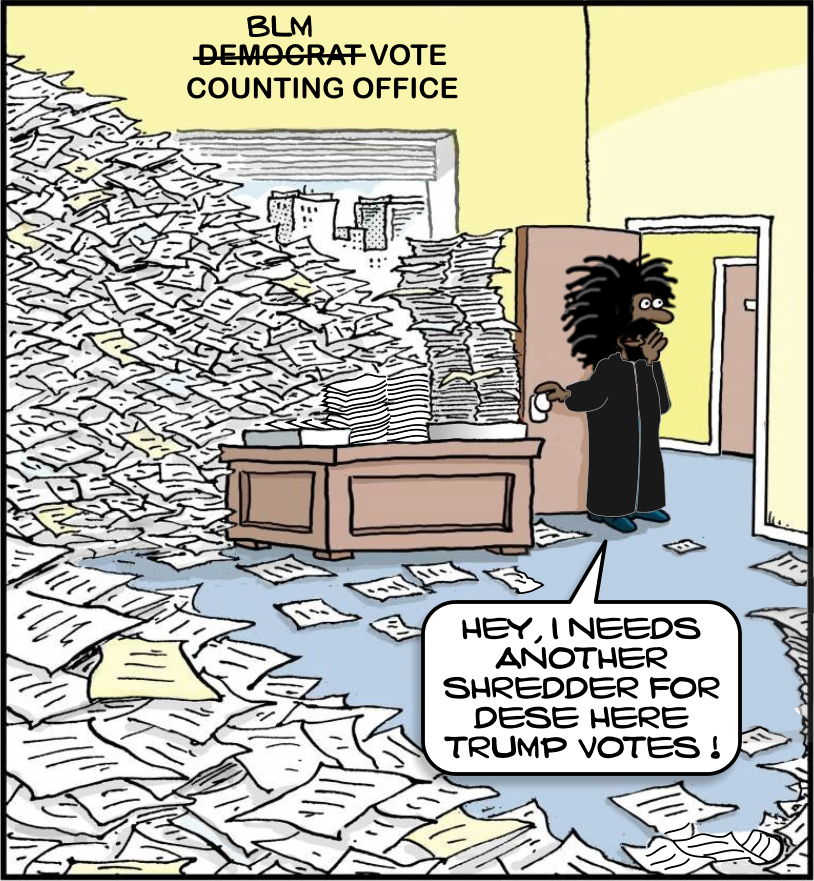
Trump’s Election
Con artists understand how to fool Humans Mark I using shells and peas. Public servants make horrendous decisions about infrastructure without raising an eyebrow from Humans Mark I. Cheats can swindle a nation out of their chosen President, while Humans 1.0 show little concern. How do fraudsters accomplish this?
Homo sapiens sapiens think that if people make a great deal of noise about something and keep making enough noise about it, they must be correct about it! It is that simple. They believe that when many people agree with something, it must be true. Democrats take advantage of this by infiltrating schools, colleges, and the media. Once they control these, they brainwash citizens, which works very effectively.
They face one major problem, however. Smart people wise up as they age, which means millions of Democrats become Republicans annually, just as millions of seedlings turn into trees. With a virtual forest of Democrats changing into Republicans each year, seasoned Democrats weather the storm with the tenacity of seafaring pirates, pushing vessels through turbulent seas toward their targets—ships captained by honest, hard-working souls. They attack such vessels with virulent hatred, slashing, cutting, burning, pounding, shooting, and stomping to victory, but, more often, defeat.
Sometimes the Left wins a battle, but they will never win the war. In the 2020 Presidential Election, Lefties tried to steal the vote using dozens of fraudulent methods, and most of the country could see straight through them. They made Americans far more aware than ever before of how corrupt the Left is. Their days of stealing elections are rapidly coming to an end, and we can all look forward to a better future.
Most of this is due to the internet, which allowed great men like Donald Trump a chance to transform America. His work is not finished, and his legacy will live on forever. Like cancer, the Left is not long for this world.
The Arrival of Humans Mark II
Evolution is a very slow process, but technology will speed our development. Genetic engineers will improve our intelligence artificially, and computer engineers will make advances in connecting brains to tiny but powerful devices. We will communicate by thinking – a form of telepathy – and be biologically linked to the internet’s vast resources. Humans 1.1 should be making the world a better place within twenty to thirty years. They will not be fooled by shell games, traffic lights, or vote stealers.




